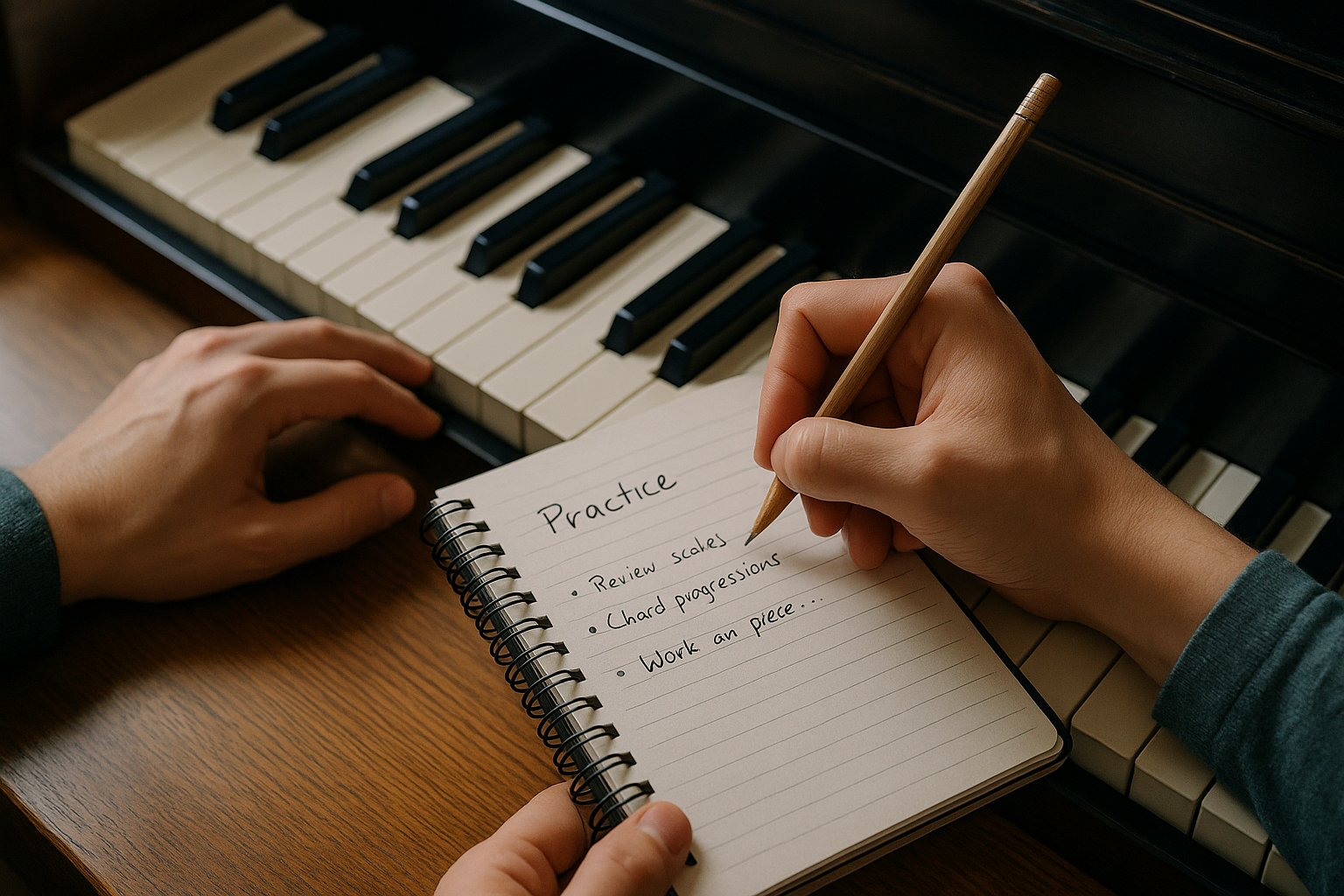Many music learners face the same problem: they practice regularly but feel stuck, unsure if they’re making progress. The reason often isn’t lack of effort but lack of structure. Without a clear system to track what you’re working on, it’s easy to repeat the same things aimlessly, overlook weaknesses, or forget achievements.
A simple yet powerful solution is to keep a practice journal. Just like athletes track their training or writers keep notebooks, musicians benefit from documenting their daily efforts. A practice journal transforms random sessions into intentional practice, making progress visible and keeping motivation strong.
This article will guide you through why a practice journal matters, how to set one up, what to write in it, and how it can supercharge your music journey.
Why Keep a Practice Journal?
At first glance, writing about practice might feel unnecessary. But keeping a journal provides several key benefits:
- Clarity: It forces you to define goals before you start practicing.
- Motivation: Seeing your progress over time is deeply encouraging.
- Accountability: Writing down your practice habits makes it harder to skip days.
- Focus: You’ll spend less time wondering “What should I practice today?”
- Reflection: Journaling helps you identify what’s working and what needs change.
In short, a practice journal turns your practice routine into a roadmap instead of guesswork.
Choosing the Right Journal Format
Your practice journal doesn’t need to be fancy. It can be:
- A simple notebook
- A planner or bullet journal
- A digital document (Word, Google Docs, Notion)
- A dedicated app for practice tracking
Choose the format you’ll enjoy using consistently. Many musicians prefer physical notebooks for their simplicity, but digital options offer flexibility, like reminders and progress charts.
What to Include in a Practice Journal
To get the most from your journal, include the following sections:
1. Date and Duration
Always start with the date and how long you practiced. This helps you track consistency and recognize patterns over time.
2. Goals for the Session
Write down what you aim to accomplish before starting. For example:
- Practice C major scale hands together at 80 BPM
- Memorize first verse of a song
- Work on fingerpicking technique for 15 minutes
3. Activities Completed
After practice, note what you actually did. Sometimes plans change, and that’s okay. Writing it down gives you an honest picture of your practice.
4. Challenges
Document what felt difficult. Maybe a chord transition was slow, or a rhythm felt confusing. These notes guide what to focus on in future sessions.
5. Successes
Equally important, record what went well. Even small wins like “played scale without mistakes” should be celebrated.
6. Reflections
At the end of the week or month, write short reflections:
- What improved?
- What still needs work?
- Did you meet your goals?
This meta-practice helps you learn not just from doing, but from observing yourself.
Designing a Daily Entry Example
Here’s how a daily entry might look:
Date: March 12, 2025
Practice time: 30 minutes
Goals:
- Review G major scale
- Practice chord transitions (G to D to C)
- Work on first verse of “Imagine”
Activities:
- Scales at 70 BPM, hands separate
- Chord transitions 10 minutes, still slow on C to D
- Verse: played smoothly at half speed
Challenges:
Switching from C to D still takes too long.
Successes:
Scale much cleaner than last week. Learned lyrics for first verse.
Reflection:
Need to increase metronome speed gradually next week. Feeling more confident singing while playing.
This short entry takes only a few minutes but provides valuable insights.
Long-Term Sections to Add
In addition to daily notes, you can include sections for broader progress:
- Repertoire list: Songs or pieces you’ve learned.
- Technical checklist: Scales, chords, or exercises mastered.
- Performance notes: Reflections on playing for others.
- Big-picture goals: What you want to achieve in 6 months or a year.
These long-term sections help you stay focused on the bigger journey.
Tips for Making Your Journal Effective
- Be consistent: Write after every practice, even briefly.
- Be honest: Note both struggles and successes.
- Stay positive: Frame challenges as opportunities, not failures.
- Review regularly: Read old entries monthly to see progress.
- Customize: Add drawings, stickers, or charts if it motivates you.
Combining a Journal with Technology
If you prefer digital tools, combine your journal with:
- Recording apps: Save audio files alongside notes.
- Spreadsheets: Track tempo increases for scales or exercises.
- Calendar reminders: Schedule practice sessions.
Digital systems can make progress even more measurable.
Why Journaling Keeps You Motivated
When progress feels invisible, flipping back through your journal reveals how far you’ve come. The messy scales, slow chord transitions, and nervous first performances remind you of challenges overcome. Your journal becomes not just a record but a story of your growth.
Final Thoughts: Your Musical Story in Writing
A practice journal is more than a notebook—it’s a companion on your musical journey. By writing daily goals, tracking activities, and reflecting on your experiences, you’ll transform practice from a routine into a structured path of growth.
Over time, your journal becomes a record of your dedication, proof of your progress, and a reminder that every small step matters.
So grab a notebook or open a document today. Write down your first entry, set a small goal, and let your practice journal guide you. Years from now, you’ll look back at those pages and see not just notes, but the story of how you became a musician.
